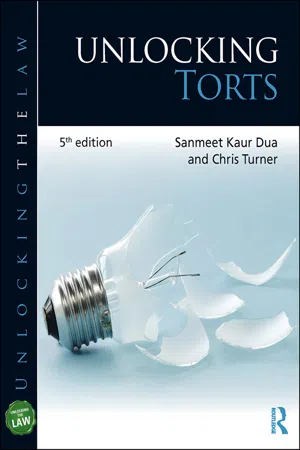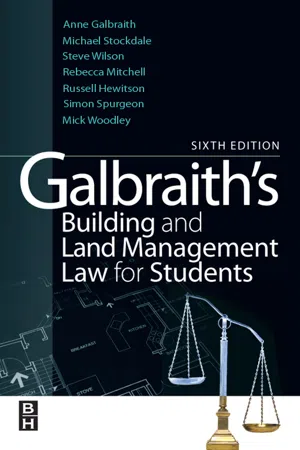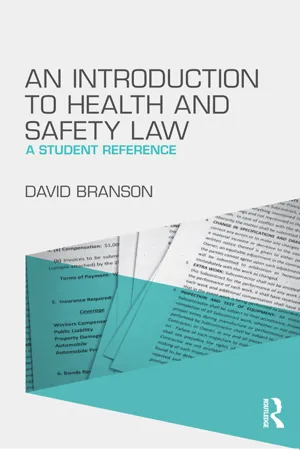Nuisance Tort
A nuisance tort refers to a legal claim that arises when one person's use or enjoyment of their property is unreasonably interfered with by another party. This interference can be in the form of noise, odors, or other disturbances. Nuisance torts can be categorized as either private (affecting an individual or small group) or public (affecting the community at large).
8 Key excerpts on "Nuisance Tort"
- eBook - ePub
- Graham Stephenson, Graham Stephenson(Authors)
- 2012(Publication Date)
- Routledge-Cavendish(Publisher)
...We shall be considering the scope of the common law actions only in this chapter, although often the solution may lie in the public law domain. The second point of an introductory nature is that the tort comprises two separate and, possibly historically distinct, causes of action, that is, public and private nuisance. Whilst it is true that they are independent actions, they often overlap and the same set of facts may well give rise to an action in both and, in addition an action under the rule in Rylands v Fletcher, assuming for the moment that that is a distinct cause of action. DISTINCTION BETWEEN PUBLIC AND PRIVATE NUISANCE A public nuisance is normally considered to be an interference or misuse which either (a) affects the exercise of some public right; or (b) substantially affects the health, safety, or convenience of a substantial number of people within the area of effect. Private nuisance is commonly regarded as an unreasonable interference with the use or enjoyment of the claimant's land or recognised interest in land. Public nuisance, it must be emphasised, is a crime as well as a tort, whereas private nuisance is a tort only. A civil action for a public nuisance would normally be brought by the Attorney General in what is known as a relator action, although the frequency of resort to this procedure has been considerably reduced by the introduction of the public law controls mentioned above. A private individual may bring an action in public nuisance provided she can show that she has suffered special damage over and above that suffered by the community at large. A private individual must take the initiative at all times in a private nuisance action. Public nuisance protects a wider range of interests in that the claimant need not have an interest in land, as is generally thought to be the case, in a private nuisance action...
- eBook - ePub
- Kenny Chin(Author)
- 2014(Publication Date)
- Routledge-Cavendish(Publisher)
...It is also actionable in tort if an individual has suffered more than the public generally. Private nuisance A generally accepted judicial definition of private nuisance is ‘an unlawful interference with a person’s use or enjoyment of land or some right, or in connection with it’. Private nuisance operates between adjacent landowners and occupiers and, therefore, only the occupier and the landlord of the adjacent land, together with the person who created the nuisance in the adjacent land, can be jointly and severally liable. It protects interests in land and, therefore, only the owner or occupier with an interest in the land affected can sue. In Malone v Laskey (1907), it was held that even the wife of the tenant would not have a right of action in nuisance. The nuisance operates against a general state of affairs rather than one isolated incident. An isolated bonfire in one’s garden or an all night noisy party will not be nuisance though other actions such as negligence if any damage has been incurred and complaints to the Environment Department and police can be taken. Examples of private nuisance include: tree branches and roots encroaching on the neighbours land; the collapse of neighbouring buildings; the use of premises as a brothel or a sex shop; a recurrence of noxious fumes, smells, dust, vibration and noise. Private nuisance must be an unreasonable use of the defendant’s land. The court will also take into consideration the locality as well. In Sturges v Bridgman (1879), it was expressed ‘what would be a nuisance in Belgrave Square would not necessarily be so in Bermondsy’. However, another ratio in the case was that there is no defence saying that the claimant comes to the nuisance. It appears that the main thing the court will look into is the interference itself. If the claimant or his property is abnormally sensitive, his nuisance action may fail...
- eBook - ePub
- Sanmeet Kaur Dua, Chris Turner(Authors)
- 2019(Publication Date)
- Routledge(Publisher)
...Could it be that the use of such schemes where they are available may become a condition precedent to the taking of court action? SAMPLE ESSAY QUESTION ‘The torts of private and public nuisance achieve different ends but are equally effective.’ Discuss the accuracy of this statement. SUMMARY ■ There are three types of nuisance: private nuisance, public nuisance and now statutory nuisance also (e.g. Clean Air Act 1993, Environment Act 1995, Environmental Protection Act 1990). ■ A private nuisance is defined as an unlawful indirect interference with a person’s use or enjoyment of his land (but not a purely recreational use). ■ Unlawful means unreasonable, and what is unreasonable can depend on locality, whether the nuisance is continuous, the sensitivity of the claimant, whether damage is caused or merely inconvenience, the presence of malice. ■ The interference must be indirect; direct interference would be a trespass. ■ Defences include: statutory authority, prescription, act of a stranger, consent and public policy. ■ A public nuisance is one that interferes with the material comfort of a class of Her Majesty’s subjects but involves damage to the claimant over and above that caused to the public generally. ■ It usually involves the highway: i.e. damage caused by obstructions to the highway, projections over the highway and the condition of the highway....
- eBook - ePub
Statutory Nuisance and Residential Property
Environmental Health Problems in Housing
- Stephen Battersby, John Pointing(Authors)
- 2019(Publication Date)
- Routledge(Publisher)
...This crossing of a property boundary is fundamentally important. Nuisance cases must involve an activity or condition affecting neighbouring property, though this should not be interpreted as being restricted solely to adjoining property. This conception of private nuisance also applies to the nuisance limb of statutory nuisance. In both cases, there is a legal requirement for the problem causing a nuisance to originate on or emanate from one property and to cause harm on neighbouring property. 4.04 The tort of private nuisance is a civil action giving rights to the owners of property to protection from activities carried out on neigh-bouring property. Besides harmful activities, it may be the condition or state of the property that causes a nuisance to neighbours. A civil action in private nuisance would usually be taken in order to obtain an injunction to prevent it from continuing or recurring. It may also include an application for damages: compensation for loss or damage that resulted from the nuisance. 4.05 Private nuisance covers a wider range of interferences to neighbouring land than statutory nuisance. An encroachment onto a neigh-bour’s land by tree roots, causing damage to the foundations of a block of flats was found to be a private nuisance in Delaware Mansions. 1 But this could not be a statutory nuisance because, firstly, this type of problem does not come within the scope of the statutory nuisances listed in s.79 EPA 1990. But there is also a conceptual reason which limits this problem only to a private nuisance action...
- Michael Stockdale, Rebecca Mitchell, Stephen Wilson, Simon Spurgeon, Russell Hewitson, Mick Woodley(Authors)
- 2010(Publication Date)
- Routledge(Publisher)
...Where this can be proved, he or she may succeed either in recovering damages, or in obtaining an injunction, or both. Sometimes, the behaviour of the defendant will constitute both a public and a private nuisance and, in such a case, the individual affected will be in an even stronger position to sue. In one case, quarrying operations had caused all the houses in the neighbourhood to be affected by dust and there was held to be both public and private nuisance. A right to sue for public nuisance may be important in those cases where a claimant would have no right to sue in private nuisance, for example in those cases where there is no interest in land to protect. Private nuisance The tort of private nuisance is committed when one person unlawfully interferes with another’s use or enjoyment of land. The interference must be unreasonable for the tort to arise. The range of activities which can amount to private nuisance is very wide and could include harm caused by smells, fumes, vibrations, noise, dust, encroachment by tree roots, escape of sewage and the keeping of noisy or smelly animals. Essentially, the law of private nuisance attempts to reconcile conflicting interests. An Englishman’s home is his castle, and he is free to do within it as he pleases, so long as he does not spoil his neighbour’s enjoyment of his own land. In a recent case, Hunter v. Canary Wharf, it was established that erecting a building that interfered with a neighbour’s television reception was not a nuisance. In seeking to apply this ‘live and let live’ approach, and when assessing whether the interference is unreasonableness, the court takes a number of factors into account. The duration of the interference is relevant, not only in establishing the existence of a nuisance but also in determining which remedy is more appropriate – damages or an injunction...
- eBook - ePub
An Introduction to Health and Safety Law
A Student Reference
- David Branson(Author)
- 2014(Publication Date)
- Routledge(Publisher)
...In this respect, it is analogous to the liability under the Occupiers Liability Acts 1957 and 1984, except that liability is to persons who are not on the land itself but on land nearby. In particular we need to focus on the case of Rylands v Fletcher (1868) and the more recent case of Cambridge Water Co. v Eastern Counties Leather (1994), which profoundly modifies the effect of Rylands v Fletcher. Most of the liability here is based on common law, but there are various statutes that impose liability, such as the Environmental Protection Act 1990, which we will consider briefly later. The Tort of Nuisance was originally land based, but in recent times it has developed into a wider liability with the growth of Public Nuisance and Statutory Nuisance. While Private Nuisance is still related to the ownership of land and provides a remedy for interference with that land, Public and Statutory Nuisance are not related to land ownership, but provide a remedy for a wider range of potential claimants. I will look at both of these areas of law below. Private Nuisance Nature of the liability The Tort of Nuisance has been defined as ‘an unreasonable interference for a substantial length of time, by an owner of property, with the use or enjoyment of a neighbouring property’, as in the case of Cunard v Antifyre (1933). This means that the claimant must have an interest in the land affected, which may involve ownership or the holding of a tenancy, but it will not extend to another person who happens to live on the land. This was made clear in the case of Hunter v Canary Wharf Ltd (1997), which overruled an earlier decision to that effect in Khorasandjian v Bush (1993). In order to claim compensation, the claimant needs to show evidence of unlawful interference with the use of his land. This will include such matters as allowing smoke, noise, noxious materials or toxic substances to come onto the claimant’s property...
- eBook - ePub
- Matthew Cousins(Author)
- 2019(Publication Date)
- Routledge(Publisher)
...There are two types of nuisance; public nuisance and private nuisance. Public nuisance is an unlawful omission or act that endangers or interferes with property, common rights, comfort and life of the general public. Public nuisance is a criminal offence. Private nuisance is not a criminal offence and involves unreasonable interference with neighbouring land and physical damage to buildings or land. Lord Lloyd of Berwick in Hunter v Canary Wharf 35 provided a simple classification: “Private nuisances are of three kinds. They are (1) nuisance by encroachment on a neighbour’s land; (2) nuisance by direct physical injury to a neighbour’s land; and (3) nuisance by interference with a neighbour’s quiet enjoyment of his land.” 36 Many private and public nuisances can be statutorily determined by a local authority issuing a notice under sections 79 and 80 of the Environmental Protection Act 1990, which sets out a number of matters that may be deemed to be statutory nuisances, including noise, pollution and smoke. There are also statutes regulating conduct amounting to nuisance, including the Noise and Statutory Nuisance Act 1993, the Clean Air Act 1993 and the Water Industry Act 1991. 35 Hunter v Canary Wharf [1997] 2 All ER 426, HL. 36 Ibid. EXAMPLES OF NUISANCE Examples of nuisance include overhanging branches, 37 interference with the reception of television broadcasts caused by the construction of a tower block, deposit of dust caused by the construction of a link road, 38 land subsidence that caused a large mound to collapse onto a neighbouring property 39 and using land for an unauthorised “acid party”. 40 An architect or any other person who unlawfully obstructs the exercise of rights enjoyed by the public at large commits a public nuisance. 41 However, an architect will not normally be liable for nuisances of which he or she was unaware...
- eBook - ePub
- Chris Monaghan(Author)
- 2015(Publication Date)
- Routledge(Publisher)
...Unfortunately, one afternoon Fatima is contacted by a colleague, who informs her that the clamps have caused the entire façade of a building to collapse. Discuss TSH Ltd’s possible liability in the tort of negligence. TRESPASS TO THE PERSON There can be liability in tort where a person has been falsely imprisoned, assaulted or suffers a battery. There is a crossover with the criminal law here. A business may face liability for trespass to the person where one of its employees physically assaults a customer. This is because the business as the employer could be vicariously liable. PRIVATE NUISANCE Key definition: Private nuisance Liability arises where the defendant has unlawfully interfered with the claimant’s enjoyment of her land. A business could be liable in the tort of nuisance if it interferes with the claimant’s enjoyment of his land. The claimant must have a right in the land (see Hunter v Canary Wharf Ltd [1997] AC 655 and Newcastle-under-Lyme Corporation v Wolstanton Ltd [1947] Ch 92). The claimant can sue for private nuisance where his enjoyment of the land is interfered with due to the defendant’s unlawful interference. In order to prevent this interference, the claimant may ask the court to grant an injunction. Whether the claimant succeeds in establishing a cause of action for actionable private nuisance will depend on many factors. In Sturges v Bridgman (1879) 11 Ch D 852, the Court of Appeal held that whether some activity amounted to nuisance would depend on the location in which it took place. For businesses this is important, as a premise such as a factory or storage facility may cause frequent noise and if there is residential housing nearby there could be a risk that one of the residents will ultimately commence legal action. Other factors include the extent of and the duration of the alleged nuisance. The court will have to consider the reasonableness of the defendant’s interference and the sensitivity of the claimant...







